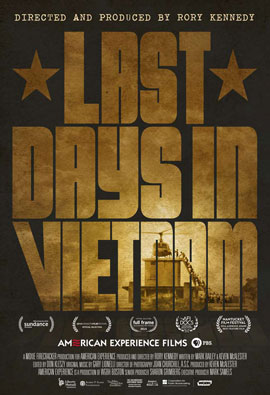It is 40 years since the US carried out its chaotic last-minute helicopter evacuation of Saigon. Rory Kennedy’s Oscar-nominated documentary, Last Days in Vietnam, tells the dramatic story of those final hours on April 29th 1975 as 75 Marine Corps helicopters flew back and forth from Saigon to the US fleet offshore in “Operation Frequent Wind” with thousands of Americans and South Vietnamese who had rushed to the US Embassy for sanctuary. And she movingly captures the feelings of guilt of some of the Americans inside the Embassy who are told that President Ford himself has ordered an end to the airlift - before all the Vietnamese inside the compound can be flown out. US Army Captain Stuart Herrington, one of the few Vietnamese speakers in the compound, is forced to lie to the remaining 420 Vietnamese waiting patiently beside the Embassy pool: “There are big helicopters coming,” he says in an attempt to prevent panic, before he sneaks into the embassy and boards the last helicopter out. Even today Herrington struggles to maintain his composure in front of Kennedy’s camera when he tells this story.
Kennedy puts the evacuation in its historical context, showing how the 1973 Paris Peace Accords were ignored by North Vietnam who invaded the South and reached the outskirts of Saigon in April 1975. And she explains how the US Ambassador, Graham Martin, had refused to contemplate the fall of Saigon until the very last minute, and so had made no plans to evacuate the many thousands of South Vietnamese who either worked for the US or who were married to US citizens, and who faced a grim future of labor camps or worse if they fell into the hands of the communists.
There are stories of heroism – of junior embassy and military officials who went behind the ambassador’s back to smuggle out South Vietnamese when it became clear that the North was going to prevail. There are the accounts of the Marine Corps pilots, one of whom flew 18.3 hours without a break after it was announced that there were no extra pilots available and “Marine Corps pilots do not get tired.” There is the remarkable story of the USS Kirk, a ship with a small heliport that received waves of helicopters flown by South Vietnamese pilots with their families and friends on board – the captain allowed the helicopters to land on his ship, unloaded the passengers and then had the aircraft pushed overboard to make room for the next landing. But there are also the anguished tales of those who were left behind, including two interviews with South Vietnamese who couldn’t get on a helicopter and spent time in communist labor camps before finally making their way to the US.
Behind the drama of thousands of US allies desperate to escape and fearful of being abandoned in Saigon, Kennedy has made a film that also speaks to the current situation of thousands of Iraqis and Afghans who are similarly afraid of being abandoned and potentially targeted for helping the US during the long wars in those countries. “It was one of the reasons for making this film,” Kennedy said afterwards in a Q&A. “There is a relevance to the wars of today: what is our responsibility to the people on the ground, and what happens when they leave?” But Kennedy said the main lesson for her in making the film was that a retreat is no time to be making strategic decisions in war. “By April 1975 the US had very few good choices. The best time to make strategic decisions is before going to war in the first place.”

